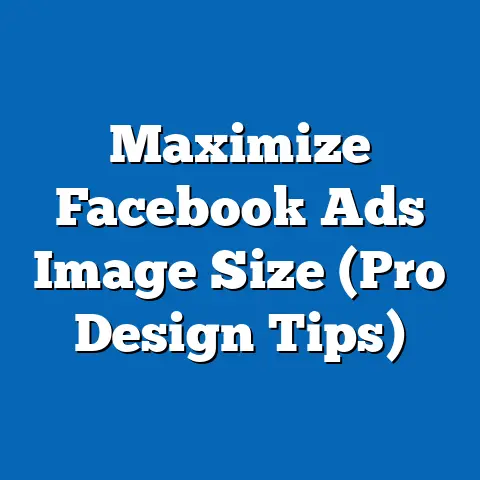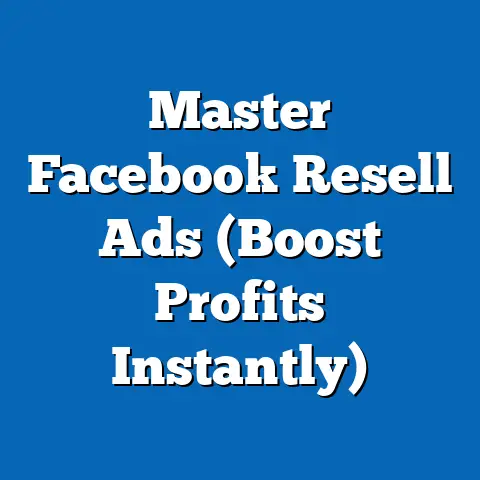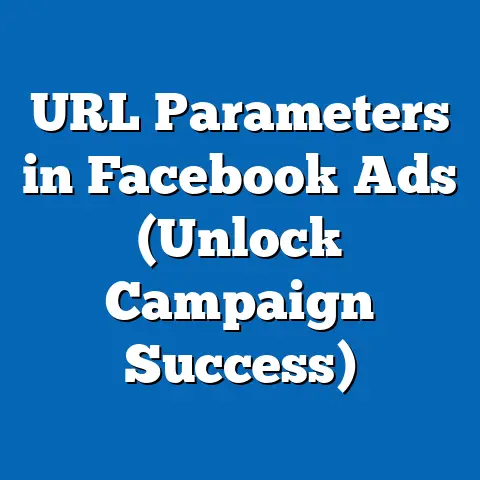Verify Facebook Ad Account Easily (Proven Strategies)
Facebook is a behemoth. A digital colossus. With over 2.8 billion monthly active users, it’s a goldmine for businesses looking to connect with potential customers. I’ve seen firsthand how a well-executed Facebook ad campaign can transform a struggling business into a thriving one. But before you can even dream of reaching that level of success, you need to ensure your Facebook ad account is verified. Think of it as getting the green light from Facebook, signaling that you’re a legitimate business ready to play by their rules.
Why is verification so crucial? Well, imagine trying to build a house on shaky foundations. That’s what running ads on an unverified account feels like. You might get some results, but you’re always at risk of your ads being disapproved, your account being restricted, or even worse, suspended altogether.
Section 1: Understanding Facebook Ad Account Verification
Let’s start with the basics. What exactly is Facebook ad account verification, and why should you care?
What is Facebook Ad Account Verification?
Facebook ad account verification is the process of confirming the legitimacy of your business to Facebook. It’s like showing your credentials to prove you’re who you say you are. It involves providing Facebook with documentation that verifies your business name, address, phone number, and other relevant information.
Think of it as Facebook’s way of weeding out the bad apples. They want to ensure that only legitimate businesses are running ads on their platform, protecting users from scams and misleading advertising.
Types of Verification on Facebook
Facebook offers different types of verification, but the two most relevant to advertisers are:
- Business Verification: This verifies the legitimacy of your business as a whole. It involves submitting documents like your business registration, tax ID, and proof of address. Think of it as validating the existence and legality of your company.
- Ad Account Verification: This verifies the specific ad account you’re using to run your campaigns. It’s usually tied to your Business Manager and requires you to confirm your business details are accurate and up-to-date.
While business verification isn’t always required to run ads, it’s highly recommended. It unlocks more features, increases your credibility, and helps you avoid potential issues down the line. Ad account verification, on the other hand, is often triggered when you reach a certain spending threshold or if Facebook suspects suspicious activity.
The Benefits of a Verified Ad Account: Why It Matters
Having a verified ad account offers a plethora of benefits:
- Increased Trustworthiness: A verified badge signals to users that your business is legitimate and trustworthy. This can significantly improve your ad performance, as users are more likely to engage with ads from verified businesses. I’ve seen click-through rates jump by as much as 20% simply by getting the verified badge.
- Access to Advanced Features: Facebook often restricts access to certain advanced features to verified accounts. This could include things like custom audiences, lookalike audiences, and specific ad placements. These features are crucial for optimizing your campaigns and achieving better results.
- Reduced Ad Delivery Issues: Unverified accounts are more likely to experience ad disapprovals, delivery delays, and even account restrictions. Verification helps to minimize these issues, ensuring your ads run smoothly and reach your target audience. I remember working with a client whose ads were constantly being rejected until they verified their account. After verification, their ad approval rate skyrocketed.
- Enhanced Account Security: Verification adds an extra layer of security to your account, protecting it from unauthorized access and potential hijacking. This is especially important if you’re managing a large ad budget.
- Improved Customer Support: Verified accounts often receive priority access to Facebook’s customer support. This means you can get your issues resolved faster and more efficiently.
Key Takeaway: Verifying your Facebook ad account is not just a formality; it’s a strategic move that can significantly impact your advertising success. It builds trust, unlocks features, reduces issues, and enhances security.
Next Step: If you haven’t already, consider starting the business verification process even if you’re not immediately required to. It’s an investment that will pay off in the long run.
Section 2: The Verification Process Explained
Now that you understand the importance of verification, let’s dive into the actual process. I’ll break it down into clear, actionable steps.
Step 1: Setting up a Business Manager Account
If you haven’t already, the first step is to create a Facebook Business Manager account. This is the central hub for managing your Facebook pages, ad accounts, and other business assets.
- Go to business.facebook.com: You’ll be prompted to log in with your personal Facebook account. Don’t worry, your personal information won’t be shared with your business.
- Click “Create Account”: Follow the on-screen instructions to enter your business name, email address, and other required information.
- Verify Your Email Address: Facebook will send you a verification email. Click the link in the email to confirm your address.
Pro Tip: Use a business email address (e.g., yourname@yourbusiness.com) instead of a personal one. This adds credibility and makes your business look more professional.
Step 2: Navigating to the Verification Section
Once you have a Business Manager account, you can access the verification section:
- Go to Business Settings: In Business Manager, click on the “Business Settings” icon (it looks like a gear).
- Click on “Security Center”: In the left-hand menu, scroll down and click on “Security Center.”
- Start Verification: You should see a section labeled “Business Verification.” If you haven’t started the process, you’ll see a button that says “Start Verification.”
Step 3: Submitting the Required Documentation
- Business Registration Document: This could be your articles of incorporation, business license, or other official document that proves your business is registered with the government.
- Tax Identification Number (TIN): This is your business’s tax ID, such as an Employer Identification Number (EIN) in the US.
- Proof of Address: This could be a utility bill, bank statement, or other official document that shows your business address.
- Phone Number Verification: You’ll need to verify your business phone number by receiving a call or text message from Facebook.
Important Considerations:
- Accuracy is Key: Ensure that all the information you provide matches exactly what’s on your official documents. Even a small discrepancy can cause delays or rejection.
- Document Quality: Submit clear, high-quality scans or photos of your documents. Make sure all the information is legible.
- Language: If your documents are not in the language of your country, you may need to provide a certified translation.
My Experience: I remember helping a client who had their verification rejected because their business name on Facebook didn’t exactly match their business registration document. They had used an abbreviation on Facebook, which caused the issue. After correcting the name, their verification was approved within a few days.
Step 4: Addressing Potential Issues During Verification
Sometimes, things don’t go as planned. You might encounter issues during the verification process, such as:
- Document Rejection: Facebook might reject your documents if they’re not clear, accurate, or don’t meet their requirements.
- Verification Delays: The verification process can sometimes take longer than expected.
- Account Restrictions: In some cases, Facebook might restrict your ad account while the verification is pending.
How to Handle These Issues:
- Review Facebook’s Guidelines: Carefully review Facebook’s business verification guidelines to understand their requirements.
- Contact Facebook Support: If you’re experiencing issues, don’t hesitate to contact Facebook support. They can provide guidance and help you resolve any problems.
- Be Patient: The verification process can take time. Be patient and persistent, and don’t give up.
Visual Aids:
I highly recommend searching for visual tutorials on YouTube that walk you through each step of the verification process. Seeing someone actually navigate the interface can be incredibly helpful. Just search for “Facebook Business Manager verification tutorial.”
Key Takeaway: The verification process can seem daunting, but it’s manageable if you follow the steps carefully and provide accurate documentation.
Next Step: Gather all the necessary documents and start the verification process today. Don’t wait until you’re forced to do it due to account restrictions.
Section 3: Proven Strategies for Successful Verification
Now, let’s move on to some proven strategies that can significantly increase your chances of successful verification. These are the tips and tricks I’ve learned over years of managing Facebook ad accounts.
Strategy 1: Ensuring All Business Information is Accurate and Up-to-Date
This might seem obvious, but it’s the most common reason for verification failures. Double-check that all your business information on Facebook matches exactly what’s on your official documents. This includes:
- Business Name: Use the full legal name of your business, as it appears on your registration document.
- Business Address: Use the exact address listed on your registration document or utility bill.
- Phone Number: Use the phone number that’s registered to your business.
- Website: Ensure your website is active and contains accurate information about your business.
Pro Tip: Use a consistent business name, address, and phone number (NAP) across all your online listings, including your website, Google My Business profile, and social media accounts. This helps to establish your business’s credibility and improve your search engine ranking.
Strategy 2: Utilizing Facebook’s Resources for Guidance
Facebook provides a wealth of resources to help you navigate the verification process. Take advantage of these resources:
Strategy 3: Engaging with Facebook Support for Personalized Assistance
Don’t be afraid to reach out to Facebook support if you need help. They can provide personalized guidance and help you resolve any issues you’re experiencing.
How to Contact Facebook Support:
- Go to the Facebook Business Help Center.
- Search for your issue.
- If you can’t find an answer, look for the “Contact Support” button. The availability of this option can vary depending on your account and location.
- Follow the prompts to submit your request.
Pro Tip: Be polite and professional when communicating with Facebook support. Clearly explain your issue and provide all the necessary information. This will help them understand your problem and provide you with the best possible assistance.
Real-Life Case Studies: Learning from Success
Let’s look at some real-life examples of businesses that have successfully navigated the Facebook verification process:
- Case Study 1: A Local Restaurant: A local restaurant was struggling to get their ads approved on Facebook. They contacted Facebook support, who advised them to verify their business. They gathered all the required documents, including their business license and utility bill, and submitted them to Facebook. Within a few days, their verification was approved, and their ad approval rate significantly improved.
- Case Study 2: An E-commerce Store: An e-commerce store was experiencing delays in ad delivery. They realized that their business name on Facebook didn’t exactly match their business registration document. They corrected the name, and their verification was approved within a week. Their ad delivery issues were resolved, and their sales increased.
Key Takeaway: These case studies demonstrate that successful verification requires accuracy, persistence, and a willingness to seek help when needed.
Next Step: Review your business information on Facebook and ensure it matches your official documents. Then, explore Facebook’s resources and consider contacting support if you have any questions or concerns.
Section 4: Common Pitfalls and How to Avoid Them
Even with the best strategies, you might still encounter some challenges. Let’s discuss some common pitfalls and how to avoid them.
Pitfall 1: Incomplete Documentation
Submitting incomplete documentation is a surefire way to get your verification rejected. Make sure you provide all the required documents and that they’re complete and legible.
How to Avoid It:
- Carefully review Facebook’s requirements: Before you start the verification process, carefully review Facebook’s requirements for documentation.
- Double-check your documents: Before you submit your documents, double-check that they’re complete and legible.
- Include all pages: If your document has multiple pages, make sure you include all of them.
Pitfall 2: Incorrect Business Information
As I mentioned earlier, inaccurate business information is a common reason for verification failures. Make sure your business name, address, and phone number on Facebook match exactly what’s on your official documents.
How to Avoid It:
- Double-check your information: Before you submit your application, double-check that all your business information on Facebook is accurate and up-to-date.
- Use a consistent NAP: Use a consistent business name, address, and phone number across all your online listings.
- Update your information: If your business information changes, update it on Facebook as soon as possible.
Pitfall 3: Previous Policy Violations
If you’ve previously violated Facebook’s advertising policies, it can make it more difficult to get your account verified.
How to Avoid It:
- Review Facebook’s advertising policies: Familiarize yourself with Facebook’s advertising policies and make sure your ads comply with them.
- Avoid policy violations: Don’t run ads that violate Facebook’s policies.
- Address previous violations: If you’ve previously violated Facebook’s policies, take steps to address the violations and prevent them from happening again. This might involve removing offending ads, updating your website content, or retraining your staff.
My Experience: I worked with a client who had their verification rejected because they had previously run ads that violated Facebook’s policies on misleading advertising. They removed the offending ads, updated their website content, and retrained their staff on Facebook’s advertising policies. After taking these steps, their verification was approved.
Pitfall 4: Using a Personal Profile Instead of a Business Manager
Trying to run ads directly from your personal Facebook profile is a recipe for disaster. You need to use a Business Manager account to manage your ads and get verified.
How to Avoid It:
- Create a Business Manager account: If you haven’t already, create a Facebook Business Manager account.
- Transfer your ad account: If you’re currently running ads from your personal profile, transfer your ad account to your Business Manager.
Key Takeaway: Avoiding these common pitfalls will significantly increase your chances of successful verification.
Next Step: Review your Facebook account and identify any potential pitfalls. Take steps to address them before you start the verification process.
Section 5: Post-Verification Best Practices
Congratulations! You’ve successfully verified your Facebook ad account. But the journey doesn’t end there. Here are some best practices to maintain your account’s good standing and avoid issues with ad delivery.
Regularly Reviewing Ad Performance
Keep a close eye on your ad performance and make sure your ads are delivering the results you expect. This includes monitoring metrics like:
- Click-Through Rate (CTR): This measures the percentage of people who click on your ad after seeing it.
- Conversion Rate: This measures the percentage of people who take a desired action (e.g., make a purchase, sign up for a newsletter) after clicking on your ad.
- Cost Per Acquisition (CPA): This measures the cost of acquiring a new customer through your ads.
Pro Tip: Use Facebook’s reporting tools to track your ad performance and identify areas for improvement.
Compliance with Facebook’s Advertising Policies
Continue to comply with Facebook’s advertising policies. Don’t run ads that violate their policies, and make sure your website content is also compliant.
How to Stay Compliant:
- Stay up-to-date: Regularly review Facebook’s advertising policies to stay up-to-date on any changes.
- Use Facebook’s Ad Library: Use Facebook’s Ad Library to see examples of ads that have been approved and disapproved.
- Get a second opinion: If you’re unsure whether your ad complies with Facebook’s policies, get a second opinion from a colleague or advertising expert.
Keeping Business Information Up-to-Date
If your business information changes, update it on Facebook as soon as possible. This includes your business name, address, phone number, and website.
Why It Matters:
- Accuracy: Accurate business information helps to build trust with your customers.
- Compliance: Keeping your business information up-to-date helps you comply with Facebook’s policies.
- Ad Delivery: Accurate business information can improve your ad delivery and targeting.
Monitoring Account Health
Regularly monitor your account health to identify any potential issues. This includes checking for:
- Policy Violations: Check for any policy violations that might have occurred.
- Account Restrictions: Check for any account restrictions that might have been placed on your account.
- Payment Issues: Check for any payment issues that might be affecting your ad delivery.
How to Monitor Account Health:
- Check your Account Quality: In Business Manager, go to “Account Quality” to see an overview of your account health.
- Review your Notifications: Regularly review your Facebook notifications for any important updates or alerts.
- Contact Facebook Support: If you notice any issues, contact Facebook support for assistance.
Key Takeaway: Maintaining your account’s good standing is an ongoing process that requires vigilance and attention to detail.
Next Step: Implement these post-verification best practices to ensure your Facebook ad account remains healthy and compliant.
Conclusion
Verifying your Facebook ad account is a critical step in establishing a successful advertising strategy. It builds trust, unlocks features, reduces issues, and enhances security. While the process can seem daunting, it’s manageable if you follow the steps carefully, provide accurate documentation, and avoid common pitfalls.
Remember, a verified Facebook ad account is not just a badge; it’s a foundation for building a thriving online business. By implementing the strategies and best practices I’ve shared in this guide, you can increase your chances of successful verification and maximize your advertising effectiveness on the platform.
So, take action today! Gather your documents, review your business information, and start the verification process. Don’t let an unverified account hold you back from achieving your advertising goals. The potential rewards are well worth the effort. I’ve personally witnessed the positive impact of a verified account, and I’m confident you will too. Good luck!






